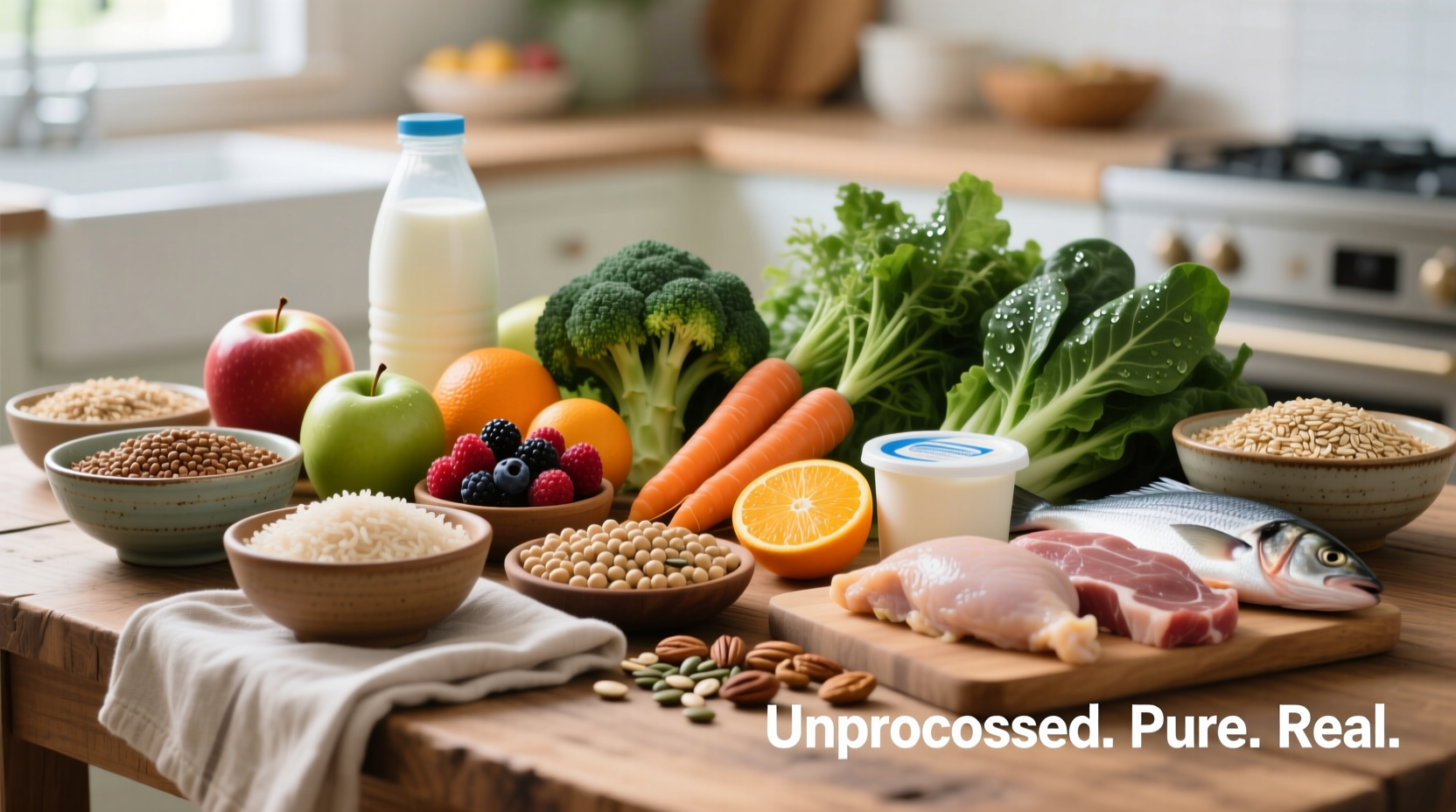Unprocessed foods are whole foods in their natural state with no additives, preservatives, or industrial modifications. These include fresh fruits, vegetables, raw nuts and seeds, whole grains in their natural form, unprocessed meats, and legumes. The key distinction is that these foods haven't been altered from their original form through industrial processes, additives, or significant preparation.
Ever wonder why nutritionists keep telling you to eat more whole foods? Understanding what foods aren't processed gives you the power to make smarter choices for your health without falling for marketing tricks. In today's food landscape filled with "natural" claims and confusing labels, knowing exactly which foods qualify as truly unprocessed helps you build a foundation for better nutrition, more energy, and long-term wellness.
What Exactly Counts as Unprocessed Food?
Unprocessed foods exist in nature exactly as you find them, requiring no industrial intervention. These foods contain only themselves—no added sugars, oils, preservatives, or artificial ingredients. When you pick an apple from a tree or dig potatoes from the ground, you're holding unprocessed food in its purest form.
According to the U.S. Dietary Guidelines, truly unprocessed foods maintain their natural nutrient profile without any industrial alteration. The Harvard T.H. Chan School of Public Health emphasizes that these foods form the cornerstone of a healthy diet because they deliver nutrients in their most bioavailable forms.
Your Complete Guide to Unprocessed Food Categories
Fresh Produce: Nature's Perfect Packages
Fruits and vegetables straight from the plant qualify as unprocessed when consumed in their whole form. This includes:
- All fresh fruits (apples, bananas, berries, citrus)
- Leafy greens and cruciferous vegetables (spinach, kale, broccoli)
- Root vegetables (carrots, sweet potatoes, beets)
- Alliums (onions, garlic, leeks)
Important distinction: Frozen fruits and vegetables without added sauces, sugars, or preservatives maintain their unprocessed status. The flash-freezing process preserves nutrients without altering the food's fundamental nature.
Whole Grains in Their Natural State
True unprocessed grains appear as they grow in fields, not as refined flours. Look for:
- Intact grains like wheat berries, oats, quinoa, brown rice
- Popcorn kernels (before popping)
- Buckwheat groats
Processed grains lose significant nutritional value during refining. As the National Institutes of Health explains, removing the bran and germ strips away fiber, vitamins, and minerals that make whole grains nutritionally valuable.
| Unprocessed Foods | Processed Counterparts | Key Differences |
|---|---|---|
| Raw almonds | Flavored roasted almonds | Added oils, salt, or sugar |
| Whole apple | Apple juice or sauce | Fiber removal, added sugars |
| Raw quinoa | Quinoa flakes or puffs | Altered structure, faster digestion |
| Plain chicken breast | Breaded chicken patties | Added fillers, preservatives, breading |
Proteins in Their Purest Form
When selecting unprocessed protein sources, look for foods that haven't been altered with additives or preservatives:
- Raw cuts of meat, poultry, and fish (no marinades or injections)
- Whole eggs
- Raw legumes (dried beans, lentils, peas)
- Nuts and seeds in their raw state
The FDA notes that even seemingly simple modifications like injecting chicken with salt solutions transforms unprocessed meat into a processed product. Always check for added ingredients that push foods out of the unprocessed category.
Understanding Context Boundaries: When Processing Makes Sense
Not all food processing is problematic. Some minimal processing preserves nutritional value while making foods safer or more accessible:
- Pasteurization of milk destroys harmful bacteria while preserving most nutrients
- Freezing fruits and vegetables locks in nutrients at peak ripeness
- Grinding whole grains into flour maintains nutritional integrity when used immediately
The key distinction lies in whether processing adds ingredients or significantly alters the food's nutritional profile. As nutrition researchers at Harvard's Nutrition Source explain, minimal processing that preserves the food's natural state still qualifies as essentially unprocessed.
Evolution of Food Processing: A Brief Timeline
Understanding food processing history helps identify truly unprocessed options:
- Prehistoric Era: Humans consumed exclusively unprocessed foods—hunted game, gathered plants
- 10,000 BCE: Agricultural revolution introduced basic processing (grinding grains)
- 19th Century: Canning and refrigeration enabled preservation without significant nutrient loss
- Mid-20th Century: Industrial food processing exploded with additives, preservatives, and refined ingredients
- Today: Ultra-processed foods now dominate supermarket shelves, making unprocessed options harder to identify

Practical Shopping Strategies for Finding Truly Unprocessed Foods
Navigating modern grocery stores for unprocessed options requires smart strategies:
Produce Section Secrets
Focus on perimeter shopping where fresh produce typically resides. Remember these tips:
- Choose whole fruits over pre-cut varieties (which often contain preservatives)
- Select loose vegetables rather than bagged options with added seasonings
- Visit farmers markets for the most direct access to unprocessed produce
Reading Between the Lines on Labels
When packaged foods are necessary, use this quick assessment method:
- Check ingredient count: Truly unprocessed foods have one ingredient
- Scan for unfamiliar additives: If you can't pronounce it, it's probably processed
- Watch for hidden sugars: Terms like cane juice, syrup, or words ending in "-ose"
- Avoid products with multiple processing steps mentioned
Building Your Unprocessed Food Lifestyle
Transitioning to more unprocessed foods doesn't require perfection. Start with these achievable steps:
Simple Swaps for Immediate Impact
- Replace sugary cereals with whole oats or quinoa flakes
- Choose plain yogurt instead of flavored varieties
- Use whole fruit for sweetness rather than added sugars
- Prepare beans from dried instead of canned versions
Meal Planning Framework
Structure your meals around unprocessed foundations:
- Build around a whole protein source (chicken breast, fish, beans)
- Add two different colored vegetables
- Incorporate one whole grain or starchy vegetable
- Finish with healthy fats from whole sources (avocado, nuts, seeds)
Research published in the American Journal of Clinical Nutrition shows that diets rich in unprocessed foods correlate with lower risks of chronic diseases and better weight management outcomes. The key isn't perfection but consistently choosing whole, unaltered foods whenever possible.











 浙公网安备
33010002000092号
浙公网安备
33010002000092号 浙B2-20120091-4
浙B2-20120091-4